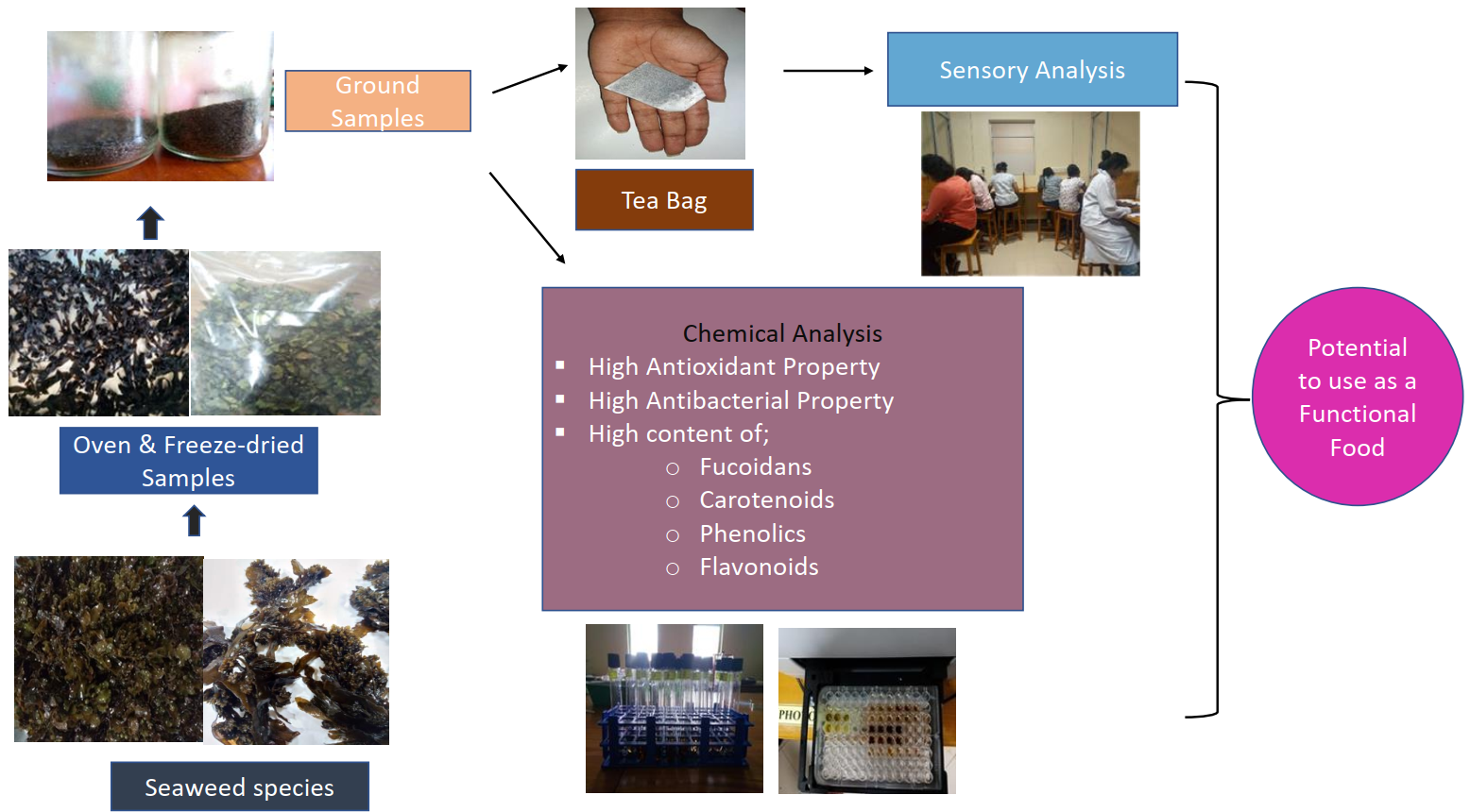Bioactive, Microbiological, and Sensory Properties of Sargassum cristaefolium and Sargassum crassifolium Herbal Tea
DOI:
https://doi.org/10.31357/ait.v2i1.5456Abstract
Sargassum is a genus of brown seaweed rich in bioactive compounds such as fucoidan which has various health promoting properties including anti-cancer activity, anti-viral activity, and anti-inflammatory activity. This study examines the potential to develop herbal tea using Sargassum cristaefolium and Sargassum crassifolium Seaweeds were collected from the southern coastal area of Sri Lanka and identified using a morphological key. Each seaweed type was thoroughly cleaned, blanched, and dehydrated either by oven-drying (40 ℃ for 48 h) or freeze-drying technique and separately ground to a coarse powder, which resulted in four treatments as oven-dried S. cristaefolium and S. crassifolium, and freeze-dried S. cristaefolium and S. crassifolium. Dried Sargassum powders were analyzed separately for moisture content, total phenolics (Folin-ciocalteu method), total flavonoids (Aluminum chloride method), and radical scavenging activity (DPPH method), total carotenoids, and fucoidan content (spectrophotometric method). Freeze-dried Sargassum powder samples gave significantly higher total phenolic content (P<0.05) compared to oven-dried Sargassum powder. Total phenolics content of S. crassifolium and S. cristaefolium were 0.73± 0.12 and 1.27± 0.32 mg gallic acid equivalents/g dry weight, respectively. Total flavonoid contents were not significantly different among the S. cristaefolium and S. crassifolium seaweed powder considering oven drying and freeze-drying method. Freeze-dried Sargassum powders gave significantly higher radical scavenging activity (P<0.05) than oven-dried Sargassum powders. Radical Scavenging activities of freeze-dried S.crassifolium and S.cristaefolium powders were 34.6%± 1.87 and 46.83±8.30%, respectively. Oven-dried Sargassum powders gave significantly higher total carotenoid content (P0.05) than freeze-dried powders. Total carotenoid content of S.crassifolium was 1.88± 0.002 µg/g dry weight while it was 1.86± 0.089 µg/g dry weight for S.cristaefolium. Freeze-dried Sargassum powders gave higher fucoidan content than oven-dried powders however there were no significant differences in the fucoidan content considering the four treatments and their tea liquors. Fucoidan content of the freeze-dried S.crassifolium seaweed powder was 30.74± 6.36 mg/200 mL, while that of S.cristaefolium was 30.0± 4.09 mg/200 mL. A 5 g weighed tea bag was brewed in 200 mL distilled water for 20 min for the preparation of herbal tea. The highest overall acceptability was taken from the oven-dried S.cristaefolium tea from the sensory evaluation. Results revealed that Sargassum powders can be successfully used as herbal tea with functional properties.

Downloads
Published
How to Cite
License
Copyright (c) 2022 Dulanji Silva, Dr. Manori Bambaranda, Dr. Deshani Mudannayake

This work is licensed under a Creative Commons Attribution-NonCommercial-NoDerivatives 4.0 International License.
The Authors hold the copyright of their manuscripts, and all articles are circulated under the terms of the Creative Commons Attribution License, which permits unrestricted use, distribution, and reproduction in any medium, as long as that the original work is properly cited.
The use of general descriptive names, trade names, trademarks, and so forth in this publication, even if not specifically identified, does not imply that these names are not protected by the relevant laws and regulations. The authors are responsible for securing any permissions needed for the reuse of copyrighted materials included in the manuscript.




